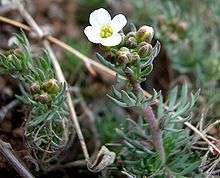Polyctenium fremontii
Polyctenium fremontii, the desert combleaf, is named both in English and Greek for its deeply lobed leaves, which almost appear to be pinnately compound. It takes the other portion of its scientific name from John C. Frémont. It is a small and compact plant native to the western United States. Leaves have forked hairs, and the distal end of the leaf often has a single hair at the very tip. It is a member of the broccoli family, and the white flowers therefore have four petals in the shape of a cross. The flowers appear in clusters at the ends of the stems.
| Polyctenium fremontii | |
|---|---|
 | |
| Scientific classification | |
| Kingdom: | Plantae |
| Clade: | Tracheophytes |
| Clade: | Angiosperms |
| Clade: | Eudicots |
| Clade: | Rosids |
| Order: | Brassicales |
| Family: | Brassicaceae |
| Genus: | Polyctenium |
| Species: | P. fremontii |
| Binomial name | |
| Polyctenium fremontii | |
This plant is rather uncommon, but is among the first plants of sagebrush country in the inland western U.S. to bloom in spring. It is found on the banks of seasonal streams and similar places.
External links
| Wikispecies has information related to Polyctenium fremontii |
- Jepson Manual Treatment of Polyctenium fremontii
- USDA Plants Profile for Polyctenium fremontii (Desert combleaf)
- Polyctenium fremontii — U.C. Photo gallery
| Wikimedia Commons has media related to Polyctenium fremontii. |